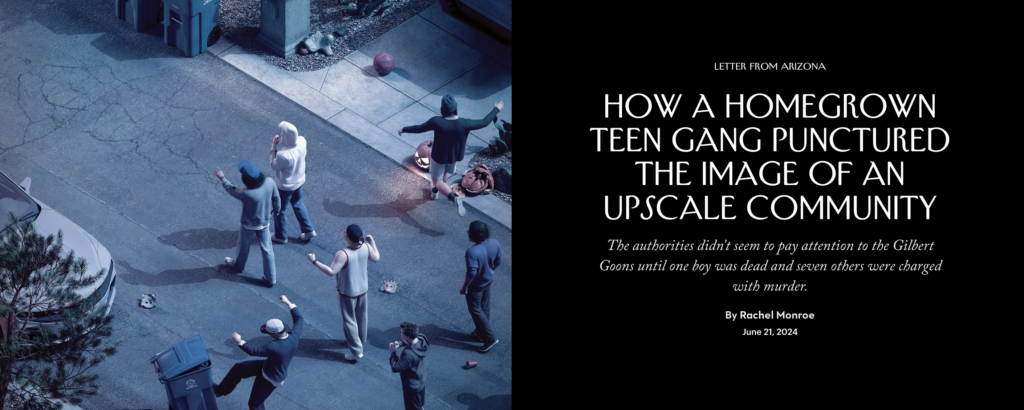
A very interesting piece the New Yorker a couple of weeks ago. Rachel Monroe documents the story of a wealthy neighbourhood in Arizona that has been terrorised by the ‘Goons’ gang of rampaging, uber-privileged kids… ending with a murder, and seven boys on trial.
In south Gilbert, the Goons looked like J. Crew models. “Some of them are pulling a 3.8 (grade point average) and have a job and play a sport, and they’re just beating people up on the weekend”
It’s a tale with many dimensions. One is the social pressures experienced by parents wanting to project an apple pie image of perfection.
Parents in the East Valley were too concerned with maintaining their public images to admit that their children were out of control. “No one talks, like, ‘My kid is being a complete shithead, I’m struggling, I don’t know what to do.’”
But the one that struck me most was the corrosive impact of having a local education system run entirely on consumer choice. Since the mid-nineties, Arizona has had open enrollment, meaning that students can attend any public school within a given district.
“It’s really eroded the sense of community and destabilized what was already a pretty destabilized system. Parents will get frustrated with something going on, rightly or wrongly, and they just say, ‘Forget it, I’m going down the street’”
Beth Lewis, the director of Save Our Schools Arizona
“Schools have to uphold this image to maintain their enrollment. And, because there’s so much competition, principals are encouraged to minimize issues to keep enrollment numbers up.”
Weinberger, a former elementary-school principal.
A month or so ago I read Brett Easton Ellis’ new novel, The Shards, which I thought was one of his best for a while. It’s set in the 80s in LA, amongst a group of very rich high school students who are almost entirely unparented. As per BEE’s literary vision, this is faux-autobiographical and, amidst the endless highways, drugs and sex, there is a shocking undertow of gruesome violence, which it is never particularly clear is unreal, real or hyperreal.
Two years ago this week I published my debut novel, MIDDLE CLASS, set in a London secondary school on the fringes of a council estate – or ‘project’, as it would be in the US. A chapter from it was shortlisted for the Bridport Prize, and people have said some incredibly kind things about it.
What struck me about the New Yorker piece was that it read as if Bret Easton Ellis had re-written MIDDLE CLASS. A nice fantasy, except this was a true story with one child dead and a deep sense of malaise about a group of young people falling into a very, very bad situation.
Tragically, as many in Arizona have understood, when schools become like the shopping malls or fast food outlets that proliferate in the rich sprawl around the town, then any sense of them being places where communities learn to cohere, struggle together and develop empathy is completely demolished. As soon as there’s an issue: we’ll leave and go elsewhere.
The customer is always right does not work when the service provider is a school.
Reflecting on this grim tale – which is now playing out with the arrest of students from these ‘good’ families from privileged, gated communities – I thought back to one of the guiding steers for MIDDLE CLASS: that a school is a place where we gather our young to learn the values of our community, preparing them to join it as adults imbued with the stories and ethics that bind us.
And my initial thought was: this is a cautionary tale of what happens when you uproot schools from that ideal and turn them into takeaways. But then I realised the opposite was true: this is precisely what has happened. Forced to become objects of consumer choice, Arizona’s schools are perfectly teaching the values of their host community, and producing adults in that exact image.
And now a child is dead, and the world that parents tried to avoid seeing is in the glaring light of the media. What now, then? What will the lesson be?
Get a copy of MIDDLE CLASS here.